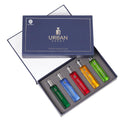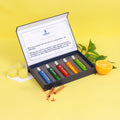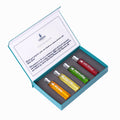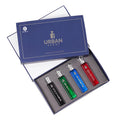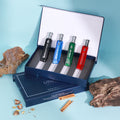Aromatic Journey: The History of Attar Perfumery

This blog explores the fascinating history and cultural significance of attar perfumery.
Imagine strolling through a beautiful garden filled with the sweet smell of roses, the earthy scent of sandalwood, and the mysterious allure of oud. This is the enchanting world of attar, a perfume oil that has fascinated the senses for centuries. Attar, a synonymous name with luxurious and enchanting fragrances, has a rich and storied past. Understanding the origin of attar and its history deepens our appreciation for the ancient art. It connects an individual to a tradition that spans millennia. Let’s embark on a captivating journey to explore the essence of attar origins and its historical evolution.
What is Attar?
Attar, also known as ittar, is a traditional form of perfume oil derived from natural sources. Unlike modern perfumes that often use synthetic compounds, attar uses natural ingredients. These typically include aromatic flowers, herbs, and spices extracted into highly concentrated oils. Each bottle of attar represents meticulous craftsmanship and deep cultural heritage. This traditional perfume defines a timeless fragrance that has been cherished for centuries.
Ingredients of Attar
The creation of attar involves a diverse range of natural ingredients, each contributing to its unique aroma. Common ingredients include roses, jasmine, sandalwood, and oud. These ingredients are carefully selected and combined using traditional methods to produce a perfume oil that is rich in scent and deeply connected to its historical roots. For instance, rose attar is known for its delicate, floral aroma, which has been celebrated in various cultures as a symbol of love and beauty. Oud attar, derived from the agarwood tree, is prized for its deep, woody scent and is often associated with luxury and sophistication.
Origin of Attar Perfumery
The origin of attar can be traced back to ancient civilizations such as Mesopotamia and Egypt. In these early cultures, fragrant oils were used for personal adornment and religious ceremonies. Attar’s role was not just a luxury but a symbol of spiritual purity and divine presence. Creating perfumes from natural extracts can be a precursor to modern perfumery. It established a foundation for the rich tradition that continues today.
In ancient Egypt, attar was integral to rituals and offerings. It was believed that the divine scent could bridge the gap between the earthly and the divine. In Mesopotamia, attar was used in ceremonies and as a sign of social status, indicating wealth and nobility. This cultural significance set the stage for attar's development and spread across different regions. The history of attar in India is also deeply rooted in tradition. Indian perfumery has its unique practices and ingredients. It reflects a rich heritage that contributes to the global story of Attar.
Attar in Historical Context
The Islamic Golden Age
During the Islamic Golden Age, Attar experienced a renaissance. Scholars and perfumers refined and developed the art of perfumery. They advanced techniques for extracting and blending natural scents. This era witnessed the emergence of notable figures who significantly contributed to the craft. Among them, Ibn al-Baitar stood out for his influential works on herbal medicine and perfumery. Their advancements in attar production techniques have had a lasting impact on the craft.
Medieval Trade Routes
The Silk Road was pivotal in spreading attar across continents. As traders transported goods between Asia and Europe, they also carried attar and other precious commodities. This exchange led to a cross-pollination of fragrance traditions, influencing European and Asian perfumery practices. The journey of attar along these trade routes highlights its importance and the allure it held for diverse cultures.
Evolution Through the Ages
Renaissance to Modern Era
The transition from natural to synthetic ingredients marked a significant shift in the history of attar. The Renaissance period saw the introduction of synthetic compounds, which revolutionized perfumery. Even with changes, the classic way of making attar remained, keeping its history alive in the evolving world of perfume making.
Contemporary Attar
Today, Attar is experiencing a revival. Modern perfumers are revisiting and reviving traditional methods, combining them with contemporary techniques. This revival is accompanied by a growing focus on sustainability and ethical practices. These efforts ensure that attar production respects both environmental and cultural values.
Cultural Significance of Attar
In Middle Eastern Cultures
Attar remains deeply embedded in Middle Eastern traditions. In these cultures, the attar is more than just a fragrance; it is a part of daily life and important ceremonies. From weddings to religious rituals, attar holds a cherished place, symbolizing purity, spirituality, and status.
In South Asian Cultures
The history of attar in India is equally rich. Traditional Indian perfumery has its own unique practices and ingredients. In India, Attar often uses local plants and is made using traditional methods. This regional variation enriches the diverse heritage of attar history.
Global Influence
Attar's influence extends far beyond its cultural origins. As it spread to the West, it left a lasting impact on global fragrance trends. The appreciation for natural, artisanal perfumes has grown. Many people worldwide are now embracing Attar for its unique qualities and historical significance.
Popular Attar Scents and Their Stories
Iconic Scents
Rose, sandalwood, and oud are among the most celebrated attar scents. Each of these iconic fragrances carries its own story and significance. For instance, rose attar, known for its delicate and floral aroma, has been used in countless rituals and as a symbol of love and beauty.
Unique Ingredients
Attar often features rare and exotic ingredients. Oud, for example, is derived from the agarwood tree and is prized for its deep, woody scent. The inclusion of such unique ingredients enhances the fragrance. It also connects the perfume to a rich heritage of natural perfumery.
Modern Applications and Innovations
Contemporary Uses of Attar
Luxury Perfumes
Attar is highly valued for its natural origins and unique qualities, making it a popular choice in luxury perfumes. This application reflects a growing appreciation for traditional attar methods.
Wellness Products
The attar is becoming more popular in products like aromatherapy oils and skincare because it is natural and pure. This trend ties back to attar origin and its historical uses for health and well-being.
Cultural Revival
The use of attar in modern products highlights how the attar history continues to influence contemporary trends. People look for attar to feel connected to its deep history by choosing well-made, crafted products.
Innovation in Attar Production
Advanced Extraction Methods
Modern technologies, such as steam distillation and cold pressing, are improving the efficiency and quality of attar production. These innovations help preserve the traditional attar history while enhancing product purity.
Blending Techniques
New methods are being developed to blend attar with other natural ingredients, creating unique and innovative fragrances. This evolution in blending reflects the ongoing adaptation of attar's rich heritage.
Sustainability Efforts
Contemporary production focuses on sustainable practices and ethical sourcing. These efforts ensure attar production respects the environment and meets modern consumer expectations. They keep attar's historical practices relevant and sustainable.
Technological Integration
Analytical tools and data-driven approaches are now used to refine attar formulations. It balances traditional craftsmanship with modern advancements. This integration supports the ongoing evolution of attar, linking attar origin and historical significance with current trends.
The journey through the history and origin of attar reveals a fascinating narrative of tradition, culture, and craftsmanship. Attar continues to enchant and inspire from its ancient beginnings to its modern resurgence. This age-old tradition, spanning millennia, will keep connecting us to its rich heritage.
Lyla Blanc takes pride in preserving the rich heritage of the attar while incorporating modern innovations. Lyla Blanc blends traditional methods with contemporary techniques. This ensures that the timeless allure of attar remains a cherished part of the global fragrance landscape. As we look to the future, the origin of attar and its deep cultural roots will continue to captivate our senses. Explore our collection of attar online and get your timeless fragrance today.
